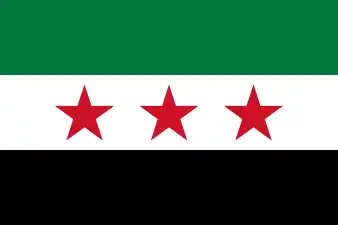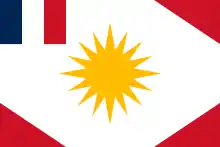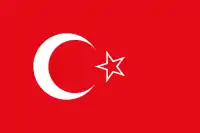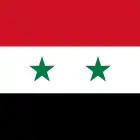As a result of the Syrian Civil War since 2011, there are at least two flags used to represent Syria, used by different factions in the war.[1] The incumbent government of the Syrian Arab Republic led by the Ba'ath Party uses the red-white-black tricolour originally used by the United Arab Republic, while Syrian opposition factions such as the Syrian National Coalition use the green-white-black tricolour known as the ''Independence flag'', first used by Mandatory Syria.
Flag of the Syrian government
 | |
| Flag of United Arab Republic (1958–1961) Flag of Syrian Arab Republic (1980–present) | |
| Use | National flag and ensign |
|---|---|
| Proportion | 2:3 |
| Adopted | 22 February 1958, abandoned on 28 September 1961;readopted on 30 March 1980[2] |
| Design | A horizontal tricolour of red, white, and black; charged with two green stars at the centre. |

The current flag was first adopted in 1958 to represent Syria as part of the United Arab Republic, and was used until 1961. It was readopted in 1980. Since its first adoption, variations of the red-white-black flag have been used in various Arab Unions of Syria with Egypt, Libya, Sudan, Yemen, and Iraq. Although Syria is not part of any Arab state union, the flag of the United Arab Republic was readopted to show Syria's commitment to Arab unity.[3] The usage of the flag has become disputed because it is often associated with the Ba'ath Party and has come to represent parties loyal to Bashar al-Assad's government in the Syrian civil war.[4]
The Syrian flag is described in Article 6 of the Syrian Constitution. The first paragraph of the Article states:
The flag of the Syrian Arab Republic consists of three colours: red, white and black, with two green stars, of five angles each. The flag is rectangular, with its width measuring two-thirds of its length. It is divided into three rectangles of identical dimensions and have the same length as the flag. The upper one is red, the middle being white and the bottom one is black, with the two green stars in the middle of the white rectangle.
The flag is based on the Arab Liberation Flag, which had four colours – black, green, white and red – representing four major dynasties of Arab history: Abbasids, Faṭimids, Umayyads, and Hashimites.[6]
Interpretation of the colors
| Color | Symbolism |
|---|---|
| Red | The Hashemite dynasty, bloody struggle for freedom.[6] |
| White | The Umayyad dynasty,[6] bright and peaceful future. |
| Green | The Fatimid dynasty or the Rashidun caliphs,[6] the stars representing Egypt and Syria.[7] |
| Black | The Abbasid dynasty,[6] strong rule.[7] |
Color approximations
Valid for: ![]()
![]()
![]()



| Red | White | Green | Black | |
|---|---|---|---|---|
| RGB | 206/17/38 | 255/255/255 | 0/122/61 | 0/0/0 |
| Hexadecimal | #ce1126 |
#FFFFFF | #007a3d | #000000 |
| CMYK | 12/100/98/3 | 0/0/0/0 | 89/27/100/15 | 75/68/67/90 |
| Pantone | 186 C | White | 7726 C | Black |
Valid for: .svg.png.webp)
| Red | White | Black | Gold | |
|---|---|---|---|---|
| RGB | 206/17/38 | 255/255/255 | 0/0/0 | 239/187/34 |
| Hexadecimal | #ce1126 | #FFFFFF | #000000 | #efbb22 |
| CMYK | 12/100/98/3 | 0/0/0/0 | 75/68/67/90 | 7/26/99/0 |
| Pantone | 186 C | White | Black | 7409 C |
Flag of the Syrian opposition
 | |
| Syrian opposition flag Syrian revolution flag[8] | |
| Use | Opposition and revolution flag |
|---|---|
| Proportion | 2:3 (disputed) |
| Adopted | Originally in 1932 with 1:2 aspect ratio, was readopted in 1961. Adopted with 2:3 aspect ratio in 2011 by opposition government-in-exile[9] (sometimes the original 1:2 aspect ratio flag is used unofficially). |
| Design | A horizontal triband of green, white, and black, with three red stars charged in the center. |
.svg.png.webp) | |
.jpg.webp)
During the ongoing civil war, the Syrian opposition, represented by the Syrian National Council, then by the National Coalition for Syrian Revolutionary and Opposition Forces[10] (commonly named the Syrian National Coalition) used a modified version of the independence flag first used in 1932 with a 2:3 aspect ratio. The modified independence flag began to be used as a universal display of the protesting opposition in late 2011.[10] The opposition wanted to distinguish themselves from the current Syrian government and favoured the use of the flag used when Syria gained its independence from France. Khaled Kamal, an official from the Syrian National Council, now believes this flag to also represent independence and the end of Bashar al-Assad's government. Today the flag is mainly used in areas controlled by the Syrian National Coalition. The use of the modified independence flag is similar to the Libyan rebels' use of the pre-Gaddafi red-black-green-white Libyan flag from the era of the Kingdom of Libya in opposition to Muammar Gaddafi's green flag.[11] The original 1:2 aspect ratio flag has been used by the opposition unofficially on several occasions.
Historic flags of Syria
Kingdom of Syria (1920)
.svg.png.webp)
The Ottoman flag had been used in Syria until Ottomans left the country on 18 September 1918. In 1918, the official flag of Syria was the Faysal flag, or Flag of the Arab Revolt, the flag of the 1916–1918 Arab Revolt against the Ottomans. It was officially adopted by the Hashemite family on 30 September 1918 and remained in use until 8 March 1920. This was the first flag to use the green/red/white/black combination seen in most subsequent Syrian flags. The colours' symbolism has been described as follows: white for the Damascene Umayyad period, green for the Caliph Ali, red for the Khawarij radical Islamic movement, and black for the Islamic prophet Muhammad, showing the "political use of religion" in opposition to the increasingly secularized Turkish colonial rule.[12] Alternately, it has been argued that the horizontal colors stand for the Abbasid (black), Umayyad (white) and Fatimid (green) Caliphates and the red triangle to the Hashemite dynasty.[13][14]
Under the Arab Kingdom of Syria, the Faysal flag was redesigned with a 7-pointed white star imposed on the red triangle, and was in use until 24 July 1920. This flag was, however, adopted by Jordan somewhat later.[3] The kingdom lasted for just over 4 months in 1920 before being occupied by France and formally incorporated into the French colonial empire for some 12 years.
French Mandate flags (1920–32)

The Faysal flag was abandoned with the arrival of French colonials to Syria. The French High Commissioner for Syria, General Henri Gouraud adopted the new flag of the French Mandate of Syria (blue with a white crescent, see below) on 24 July 1920. The flag was based on the flag of the Shebab Emirate used between 1697 and 1842, which stood for "the love of peace".[15] Gouraud's flag was in use until 1 September 1920, after which Syria was split into separate territories, each eventually given its own flag (see below).[16][12] On 22 June 1922 Gouraud established the Federation of Syria, which used a green-white-green flag with a French flag canton. When this federation was consolidated into the State of Syria in 1925 the same flag continued to be used until the establishment of the republic on 14 May 1930.[17][18]
Independence flag
French Mandate and independence (1930–58, 1961–63)
.svg.png.webp)
The flag of the newly established Syrian Republic, under the French mandate was determined by the 1930 constitution. The constitution was drafted by a parliamentary committee led by nationalist leader Ibrahim Hananu.[19] At first, French authorities refused to allow the constituent assembly to ratify the constitution, and Henri Ponsot, the High Commissioner of the Levant, dissolved the assembly on 5 February 1929. After a public uproar, French authorities rescinded their decision and decided to approve the draft with some changes.[20] On 14 May 1930, Ponsot issued decree number 3111, which approved the Syrian-drafted "Constitution of the Syrian Republic", and which in Article IV of Part I states:
"[The] Syrian flag will be as follows: length double width, and is divided into three parallel and equal colours, the highest green, white then black, that the white section contains in a straight line three red five-pointed stars".
— Article IV, Part I, Constitution of the Syrian Republic[21]
The flag's green colour stood for the Rashidun, white represented the Umayyads and black symbolised the Abbasids. Originally, the three red stars represented the three districts of Syria: the "states" of Aleppo, Damascus, and Deir ez-Zor.[12] In 1936, the Sanjak of Latakia and Jebel Druze were added to Syria, and the representation of the three stars was changed, with the first representing the districts of Aleppo, Damascus and Deir ez-Zor, the second Jebel Druze, and the final star representing Sanjak of Latakia.[18] The flag was used as a symbol for the desire for autonomy, for Syrians to rally around when France reneged on its agreement to leave the country, due to the outbreak of World War II.[22][12] The symbolism was as follows: black for the dark oppressed past, white for a promising future and red for the blood to be sacrificed to move from the former to the latter.[12] The flag was adopted when Syria gained its independence on 17 April 1946.[3] The standard was used until the creation of the United Arab Republic, a state union of Syria and Egypt, in 1958. After the collapse of the United Arab Republic, Syria continued to use the UAR's flag until 28 September 1961, when the independence flag was restored to disassociate Syria from the former failed union.[3]
Ba'athist flags
.svg.png.webp)
.svg.png.webp)
.svg.png.webp)
The current two-star flag of Syria was first adopted by Gamal Abd al-Nasser, president of Egypt and president of the United Arab Republic.[23] The flag was changed from the former independence flag in April 1958 along with associated laws designed to create a greater Arab identity.[23] The new flag took the coloured red-white-black bands from the Egyptian revolutionary flag, and the stars on the flag were changed from red to green to indicate the pan-Arab colours. The two stars represented Egypt and Syria.[24]
After Syria left the UAR on 28 September 1961, the previous independence flag was readopted to disassociate Syria from the failed union.
Following the 1963 Ba'athist coup d'état,[25] a new flag was adopted by its Revolutionary Command Council on 8 March 1963, and was used until 1 January 1972.[3] In 1963, the Ba'athist regime came to power in Iraq as well, and the two Ba'athist governments began negotiations in Cairo in order to once again form a union between Egypt, Syria and Iraq. The process failed after the Iraqi Ba'athist government was overthrown in November 1963 but both Syria and Iraq did adopt a new flag to represent the union.[26] This flag was not much different from the flag of the UAR, with only a change from two stars to three, in order to represent the addition of Iraq to the Federation.[3] The three stars represented the unity of Egypt, Syria and Iraq, as well as three pillars of Ba'athism: unity, freedom, and socialism.[27]
President Hafez al-Assad adopted a new flag on 1 January 1972, as Syria joined Egypt and Libya in the Federation of Arab Republics. The green stars were replaced by the Hawk of Quraish (the symbol of the tribe of the Prophet Muhammad).[12] The eagle held the ribbon with the name of the Federation, but unlike Egypt and Libya, Syria did not include its name on the coat of arms.[18] This flag was an official flag during the October War in 1973.[3] The Federation was dissolved in 1977, but Syria continued to use the flag for the next three years.[18] The flag was abrogated on 29 March 1980,[3] and replaced by the current two-star flag[27] in order to show Syria's commitment to Arab unity.[3]
List of flags of Syria
.svg.png.webp) Flag of the Arab Kingdom of Syria (1920)
Flag of the Arab Kingdom of Syria (1920).svg.png.webp) Henri Gouraud's flag of the Mandate of Syria (1920)
Henri Gouraud's flag of the Mandate of Syria (1920) Flag of the State of Aleppo (1920–1925)
Flag of the State of Aleppo (1920–1925) Flag of the State of Damascus (1920–1925)
Flag of the State of Damascus (1920–1925) Flag of the Alawite State (1920–1936)
Flag of the Alawite State (1920–1936).svg.png.webp) Flag of the Jabal Druze State (1921–1924)
Flag of the Jabal Druze State (1921–1924).svg.png.webp) Flag of the Jabal Druze State (1924–1936)
Flag of the Jabal Druze State (1924–1936).svg.png.webp) Civil flag of the Jabal Druze State (1921–1936)
Civil flag of the Jabal Druze State (1921–1936) Flag of the independent Hatay State (1938–1939)
Flag of the independent Hatay State (1938–1939) Flag of the Syrian Federation (1922–1925) and the State of Syria (1925–1930)
Flag of the Syrian Federation (1922–1925) and the State of Syria (1925–1930).svg.png.webp) Flag of the First Syrian Republic (1930–1950) and the Second Syrian Republic (1950–1958)
Flag of the First Syrian Republic (1930–1950) and the Second Syrian Republic (1950–1958).svg.png.webp) Flag of the United Arab Republic (1958–1961)
Flag of the United Arab Republic (1958–1961).svg.png.webp) Flag of the Syrian Arab Republic (1961–1963)
Flag of the Syrian Arab Republic (1961–1963).svg.png.webp) Flag of the Syrian Arab Republic (1963–1972)
Flag of the Syrian Arab Republic (1963–1972).svg.png.webp) Flag of Syria in the Federation of Arab Republics and after (1972–1980)
Flag of Syria in the Federation of Arab Republics and after (1972–1980) Flag of the Syrian Arab Republic (1980–present)
Flag of the Syrian Arab Republic (1980–present) Flag used by the Syrian National Coalition and Interim Government (2011–present)
Flag used by the Syrian National Coalition and Interim Government (2011–present) Flag of the Syrian Salvation Government[28] (2018–present)
Flag of the Syrian Salvation Government[28] (2018–present)
Flags of heads of state
.svg.png.webp) Royal standard of the King of the Arab Kingdom of Syria (1920)
Royal standard of the King of the Arab Kingdom of Syria (1920).svg.png.webp) Standard of the president of the Syrian Republic (1941–1958 and 1961–1963)
Standard of the president of the Syrian Republic (1941–1958 and 1961–1963).svg.png.webp) Standard of the president of the United Arab Republic (1958–1961)
Standard of the president of the United Arab Republic (1958–1961).svg.png.webp) Standard of the president of the Syrian Arab Republic (1963–1972)
Standard of the president of the Syrian Arab Republic (1963–1972).svg.png.webp) Standard of the president of the Syrian Arab Republic (1972–1980)
Standard of the president of the Syrian Arab Republic (1972–1980) Standard of the president of the Syrian Arab Republic (1980-present)
Standard of the president of the Syrian Arab Republic (1980-present)
Military flags




 Syrian Air Force ensign
Syrian Air Force ensign
See also
References
- ↑ "Debate: The New Syria between Flags and Languages | SyriaUntold | حكاية ما انحكت". Retrieved 30 August 2022.
- ↑ Ipavec, Eugene (17 March 2012). "Syria". Flags of the World. Retrieved 7 August 2012.
- 1 2 3 4 5 6 7 8 9 "Syrian Flag". History of Syria. Retrieved 7 August 2012.
- ↑ Moubayed, Sami (6 August 2012). "Capture the Flag". Foreign Policy. Retrieved 8 October 2014.
- ↑ "English Translation of the Syrian Constitution". Qordoba. 15 February 2012. p. 8. Retrieved 14 November 2012.
- 1 2 3 4 5 "Come to Syria | Syrian flag | National Anthem of Syria | Facts about Syria". Cometosyria.com, Syria guide – Come to Syria.
- 1 2 "Syria Flag – colors, meaning, history of Syria's Flag". facts.co. Archived from the original on 6 January 2018. Retrieved 5 January 2018.
- ↑ "Syrian rebels raise a flag from the past". Financial Times. 30 December 2011. Archived from the original on 10 December 2022.
- ↑ "الائتلاف الوطني لقوى الثورة والمعارضة السورية". www.etilaf.org.
- 1 2 "Syria halts Homs siege as Arab monitors arrive". CBS News. 27 December 2011. Retrieved 30 August 2012.
- ↑ Daraghi, Borzou (30 December 2011). "Syrian rebels raise a flag from the past". Archived from the original on 10 December 2022. Retrieved 7 August 2012.
- 1 2 3 4 5 6 Sergie, Lina (2003). Recollecting history : songs, flags and a Syrian square (Thesis thesis). Massachusetts Institute of Technology. hdl:1721.1/70372.
- ↑ Edmund Midura, "Flags of the Arab World" Archived 5 December 2014 at the Wayback Machine, in Saudi Aramco World, March/April 1978, pages 4–9
- ↑ Mahdi Abdul-Hadi, "Palestine Facts: The Meaning of the Flag" Archived 22 December 2013 at the Wayback Machine
- ↑ Klimeš, Roman (2021). "The Cedar Tree – The Symbol of a Country" (PDF). 25th International Congress of Vexillology. p. 4.
- ↑ Sache, Ivan; Ollé, Jaume (29 March 2012). "Historical Flags Until 1932 (Syria)". Flags of the World. Retrieved 22 November 2012.
- ↑ "Historical Flags Until 1932 (Syria)".
- 1 2 3 4 Ipavec, Eugene; Martins, António; Heimer, Željko; Dotor, Santiago (10 June 2011). "Historical flags since 1932". Flags of the World. Retrieved 7 August 2012.
- ↑ Thompson 2000, p. 52.
- ↑ Schumann 2008, p. 204.
- ↑ The 1930 Constitution is integrally reproduced in: Giannini, A. (1931). "Le costituzioni degli stati del vicino oriente" (in French). Istituto per l’Oriente. Retrieved 31 March 2012.
- ↑ Lawson 2006, p. 46.
- 1 2 Podeh 1999, p. 120.
- ↑ Mills, T. F. (10 March 2012). "Pan-Arab Colours". Flags of the World. Archived from the original on 13 November 2012. Retrieved 24 November 2012.
- ↑ King 2009, p. 41.
- ↑ Goodarzi 2006, p. 14.
- 1 2 "Discover Syria" العلم السوري (in Arabic). Discover Syria. Archived from the original on 15 September 2012. Retrieved 7 September 2012.
- ↑ Borhan, Hasan (11 December 2018). "Salvation Government adopts new flag instead of Syrian Revolution; detentions and kidnappings occur in Idlib and Daraa". smartnews-agency.com. SMARTNews Agency. SMART news. Archived from the original on 7 June 2019. Retrieved 7 June 2019.
Bibliography
- Goodarzi, Jubin M. (2006). Syria and Iran: Diplomatic Alliance and Power Politics in the Middle East. I.B. Tauris. ISBN 9781845111274.
- Heydemann, Steven (1999). Authoritarianism in Syria: Institutions and Social Conflict, 1946–1970. Cornell University Press. ISBN 9780801429323.
- Lawson, Fred H. (2006). Constructing International Relations in the Arab World. Stanford University Press. ISBN 9780804753722.
- King, Stephen J. (2009). The New Authoritarianism in the Middle East and North Africa. Indiana University Press. ISBN 9780253353979.
- Podeh, Elie (1999). The Decline of Arab Unity: The Rise and Fall of the United Arabic Republic. Sussex Academic Press. ISBN 9781902210209.
- Schumann, Cristoph (2008). Liberal Thought in the Eastern Mediterranean: Late 19th Century Until the 1960s. BRILL. ISBN 9789004165489.
- Thomas, Martin (2007). Empires of Intelligence: Security Services and Colonial Disorder after 1914. University of California Press. ISBN 9780520251175.
- Thompson, Elizabeth (2000). Colonial Citizens: Republican Rights, Paternal Privilege, and Gender in French Syria and Lebanon. Columbia University Press. ISBN 9780231106610.
Further reading
- Mohammad Dibo Debate: The New Syria between Flags and Languages, SyriaUntold 14 June 2016.
- Hanano, Amal. "This Flag is my Flag". Jadaliyya – جدلية. Retrieved 23 November 2018.
- Syria at Flags of the World

